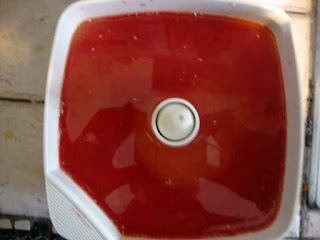Arancia (orange) is, as in English, both a color and a fruit. During February in Italy, citrus is king. The season actually starts in January and is still going strong now in March, but February is the peak. Southern Italy is the citrus region of Italy and Sicily is its epicenter. While we were there you could buy fresh, ripe fruit picked that morning from a tree for 50 euro cents per kilogram. That translates to around 30 US cents per pound.
So, what is an orange like? Italians tend to be picky and local about their produce. Oranges tend not to be around unless they are in season in Italy. They don’t ship them in semi-ripe from other parts of the world, paint them orange and sell them. What you get is fruit, tree-ripe and ready to eat, no colors added. While Italians are picky about flavor and freshness, and they care about the finished presentation of the meal on the plate, they tend not to care how the outside looks, so there is no need for a perfect fruit.
I counted this morning and my local fruit store has no fewer than 13 different orange options. Your basic fruit comes down to Clementine, mandarine, navel, tarocco and sanguinelle. In a similar fashion to the US, fruit is graded by size with different sizes costing different amounts. However, unlike the US where they are sold by the box, in Italy this also includes clementini. They are so sweet they might as well be candy. I was eating an average of 10 a day during early February before we went to Sicily. When oranges are ripe, it is difficult to pick them without creating a hole in the skin where the fruit attached to the branch. For this reason, oranges are often sold “in foglia” or with leaves, meaning there is a small amount of branch left attached to the fruit. The fruit is sometimes divided even further based on where it was grown. For instance, this morning I bought arancia tarocco di Calabria or tarocco oranges from Calabria. Two varieties of orange are essentially unavailable in the US. Those are the tarocco and sanguinelle. Tarocco usually have a reddish hint to their skin and sanguinelle can be almost red on the outside. This mirrors what you will find on the inside. Tarocco are mostly orange with a hit of red and sanguinella are blood oranges which are mostly red inside.
For the past month I have been making Amy freshly squeezed orange juice every morning before I head to work. The tarocco create a lovely pink juice and the sanguinelle are bright red. I tend to use a mixture of the two types when making her morning treat. Below is a picture of the two types of orange, shown cut in half and lined up on a cutting board. Two are tarocco and one is sanguinelle.
Next is the juice in the juice machine.
Finally we have the finished glass of juice, presented in a ring of fresh oranges.
An interesting side note. What we refer to as yellow at a traffic light in the US is often called an orange light in Italy. In truth, the color here is slightly different and closer to what we would also refer to as orange than to yellow.



No comments:
Post a Comment